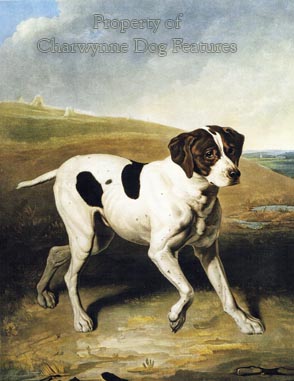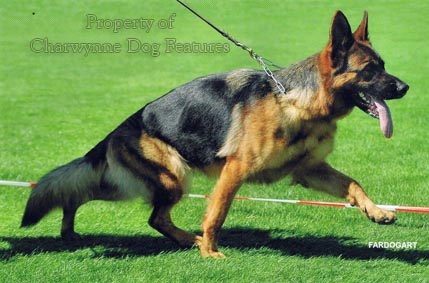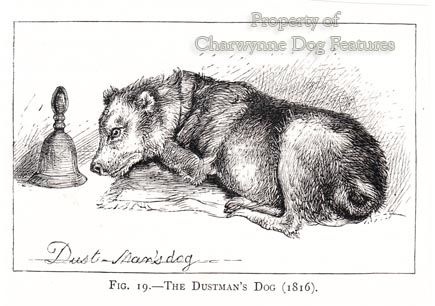616 Style Before Subsrance
PUTTING STYLE BEFORE SUBSTANCE
by David Hancock
 When style is mentioned in connection with dogs, I immediately think of setters and pointers. But if you look at old prints and paintings of our native bird dogs, they depict dogs far more substantial than the current fashion. Setters and Pointers as depicted in the last two centuries display far more muscle than today's show ring dogs without looking at all cloddy. The skill of the pedigree dog breeder is to produce quality and uniformity without losing type. When that type itself falls victim to fashion or the style of the decade, it becomes, for me, a matter of man exploiting dog and not always for dog's benefit. Bird-dogs have leg muscle for their designed purpose not to suit a style.
When style is mentioned in connection with dogs, I immediately think of setters and pointers. But if you look at old prints and paintings of our native bird dogs, they depict dogs far more substantial than the current fashion. Setters and Pointers as depicted in the last two centuries display far more muscle than today's show ring dogs without looking at all cloddy. The skill of the pedigree dog breeder is to produce quality and uniformity without losing type. When that type itself falls victim to fashion or the style of the decade, it becomes, for me, a matter of man exploiting dog and not always for dog's benefit. Bird-dogs have leg muscle for their designed purpose not to suit a style.
All too soon the fashion for needlessly heavy coats on admirable working breeds like the Beardie, the Rough Collie, the Shetland Sheepdog and the Bobtail, important native breeds, could become the only acceptable style. Hungarian breeds like the Puli and the Komondor seem to be able to cope with heavy coats -- which may be natural to them. But the British pastoral breeds haven't always had such heavy coats. The Collie is susceptible to all the dermatoses which affect the modern dog. The Beardie is still a working dog in some places but may in time feature the heavy coats now apparently de rigueur in the show ring. On all the collie breeds, the coat should 'fit well', still allow the outline to be discerned. A heavy overcoat even affects the way we walk – our style of moving.
When I first worked in Germany, over forty years ago, two of their native breeds, the Boxer and the Schaeferhund or Alsatian, were markedly different from the type favoured in contemporary show rings. A local car dealer used Boxers as guard dogs; they were solid black and strongly muscled. Today's Boxers seem half their weight and appear only favoured when carrying the 'Irish' markings: white feet, blaze and brisket. The German Shepherd Dogs I encountered on remote farms in Westphalia were like those I had used in the Malayan emergency: with a level top line, well-boned and only moderately angulated in the hindquarters. At World Dog Shows I see GSDs with dreadful bent backs, their hindquarters so exaggerated that the dog has to rest its whole rear pastern on the ground for comfort and with tails so long they drag along the surface of the ground. It's difficult to make sense of this an exaggeration inflicted by the breed.
Abroad I have seen English Toy Terriers styled more like Chihuahuas than their own ancestors, if old paintings are at all representative. 81 Black and Tan Terriers were registered with the Kennel Club in 1908, in the Toy Division; in 2009 only 113 were registered as English Toy Terriers (Black and Tan). Human whim is difficult to check but it would be sad to see this old native breed unwanted by the public. In Toy Dogs, written and published by Lillian Raymond-Mallock early in the last century, she writes: "There has been a gradual falling off in the good old toy black and tan terrier in recent years...In this variety possibly more than others, the apple head and goggle eyes are too much in evidence...They should be counterparts of the Manchester terrier, any approach to the Italian Greyhound type being most objectionable." She wouldn't have liked today's fashion.
At times in the pedigree dog world there is a distinct impression given that style and fashion are more important to some than breed type and breed characteristics. Yet fifty years ago, in his informative book, 'The Practical Guide to Showing Dogs' (Popular Dogs, 1956), Capt R Portman-Graham emphasised the need for each breed to be shown differently: "The aim of the handler is to manoeuvre his dog in the way most likely to display the special characteristics and points of its breed, and to bring out the temperament which is expected from that breed." He would not have approved the strange desire for a shepherd dog to have to demonstrate 'gaiting' at great speed!
Portman-Graham went on to condemn the odious too-tight a lead fashion, writing: "To strangle a terrier in a tight noose, and dangle it with its feet scarcely touching the ground in the attitude of a marionette, is not good handling." Neither is it good judging to allow it. How can any judge possibly assess movement when a tight lead is preventing proper contact between a dog's feet and the ground? It encourages faking. But it is happening in more and more breeds and is being condoned by more and more judges. To see any dog show judge pretending to judge the movement of exhibits strung up on a tight lead is a sad commentary on the competence of that judge. It would be a huge advance if the Kennel Club were to decree that every breed must move on a slack lead and be held on a slack lead when stacked.
Exhibiting dogs can be a rewarding pastime, but the fashions involved should not provide an arena for self-promotion. Dogs should not be discomforted in the ring and breed characteristics should be valued and exemplified, not subsumed into a common practice. The show ring has one huge huge disadvantage, whatever the ruling fashion: it cannot reveal the dog's capability. We must be vigilant if we are not to lose character, determination, working prowess, instinctive behaviour, individuality, courage, intelligence and fortitude. A handsome dog without character has cosmetic appeal and is likely to win in the show ring but for me it has no breeding potential. I would place character ahead of any other virtues. Style is for showing off; fashion is blind copying.
It is worth remembering the extraordinary racehorse in America which triumphed over serious defects by sheer determination. 'Seabiscuit' achieved 33 race wins, 13 track records at 8 tracks over six distances, including a world record over half a mile and a track record over twice that distance. But he was a stunted colt, with asymmetrical knees and permanently damaged legs. Even a ruptured suspensory ligament, spelling early euthanasia for other horses did not halt his career. Interestingly his jockey had been abandoned at a racecourse as a child and was blind in one eye. The genes for character and determination are those that provided us with the breeding stock from which we now plan to produce perfection of form.
Breeds of dog are now fashioned by show criteria but we would be more than stupid if we bred solely for looks. The working dog fraternity might claim that that what's been happening for a century in the show dog world, a world in which a dog which is useless can still have high value. Not being an exhibitor I can choose my next pup on how I think its character might develop. But I must admit that I hope the pup I choose will become a handsome adult. But those purebred dog breeders who rely on the pet market for valuable income need characters. Fashions come and go but memorable dogs are with us forever.